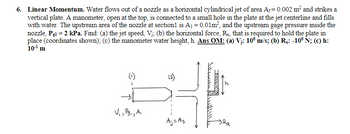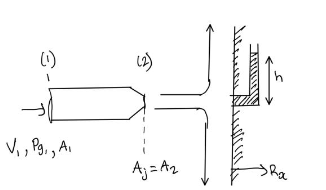
Concept explainers
The Laws of Physics are written for a Lagrangian system, a well-defined system which we follow around – we will refer to this as a control system (CSys). For our engineering problems we are more interested in an Eulerian system where we have a fixed control volume, CV, (like a pipe or a room) and matter can flow into or out of the CV. We previously derived the material or substantial derivative which is the differential transformation for properties which are functions of x,y,z, t. We now introduce the Reynold’s Transport Theorem (RTT) which gives the transformation for a macroscopic finite size CV. At any instant in time the material inside a control volume can be identified as a control System and we could then follow this System as it leaves the control volume and flows along streamlines by a Lagrangian analysis. RTT:DBsys/Dt = ∂/∂t ʃCV (ρb dVol) + ʃCS ρbV•n dA;
uses the RTT to apply the laws for conservation of mass, momentum (Newton's Law), and energy (1st Law of
(steady state - single pipe). The head losses are due to viscous friction effects; for ideal, inviscid flows hL = 0.
Bernoulli Eq’n (EB), as : ∆ (P/ρg + V2/2g + z) = +/- hS - hL . The shaft head work hS ≡ WS/(mg) is + for work in (pumps) and for work out (turbines). The 2nd Law of Thermodynamics requires that the viscous loss head hL is always > 0.
For SSSP CV problems, conservation of mass and momentum, m = ρVA = constant [mass flow rate, kg/s], and ∑F = m ( Vout - Vin) . While V is a scalar (speed) in the mass and EB eqns, V is a vector in the SSSP momentum CV eqn. assume adiabatic flow, neglect viscous effects, assume all units are SI consistent; Take Patm = 105 Pa ; ρwater ~ 1000 kg/m3 ; ρair ~ 1.2 kg/m3 ; g = 9.8 m/s2 ; Indicate CVs clearly

Given:

To find;
Step by stepSolved in 4 steps with 1 images

- m, zm 2. Two particles of equal masses move on a frictionless harizontal surface. Their center of kr? mass is fixed and their potential energies are krž and Also, they interact with each other with potential 2 akr2 Ris the distance between the masses, and k and a are positive constants. a. Find the Lagrangian in terms of the center of mass position CM, R and the relative position r. b. Solve the Lagrange equations for the relative coordinates X,Y and x,y. c. Explain the physical outcome of the results obtained in b.arrow_forwardThe Helmholtz free energy of a liquid column that rises, due to surface tension, inside a capillary tube (Figure 1), as a function of the height, h, is given by: F(h) =(ro)gr^2h^2/2 = -2 pi sigma r h cos teta, where r is the radius of the tube, g is the local ac- celaration of gravity, is the surface tension of the liquid, and is the contact angle of the liquid in contact with the wall of the tube. (a) From this expression, obtain the value of h as a function of the other physical parameters at equilibrium.Calculate the height that water will rise in a capil-lary of diameter 0.05mm. Assume that the contactangle between the water and the tube is zero. Thesurface tension of water at experimental conditionsisσ= 7.73×10−2N/m, and the local accelarationof gravity isg= 9.7m/s2.arrow_forwardPlease show all work clearlyarrow_forward
- Carbon dioxide has a specifi c heat ratio of 1.30 and a gasconstant of 189 J/(kg ∙ ° C). If its temperature rises from20 to 45 ° C, what is its internal energy rise?( a ) 12.6 kJ/kg, ( b ) 15.8 kJ/kg, ( c ) 17.6 kJ/kg, ( d ) 20.5 kJ/kg,( e ) 25.1 kJ/kgarrow_forward2. An example of a linear decreasing model could be inventory in a warehouse that ships the same number of items each day. We will assume that this warehouse is going out of business, so no new calculators are being sent to the warehouse. Calculators in warehouse Calculators sold per day number of calculators sold per salesperson per day salespeople 2(a). Notice that this model has additional components shown as converters. Based on the titles of the converters, write the equation that must have been used to calculate the flow value in this model. Be sure to include appropriate units. Set the initial number of calculators to 10,000 {calculators}. If nnd that they each sell 15 modelarrow_forwardAn object attached to a spring undergoes simple harmonic motion modeled by the differential equation d²x = 0 where x (t) is the displacement of the mass (relative to equilibrium) at time t, m is the mass of the object, and k is the spring constant. A mass of 3 kilograms stretches the spring 0.2 meters. dt² Use this information to find the spring constant. (Use g = 9.8 meters/second²) m k = + kx The previous mass is detached from the spring and a mass of 17 kilograms is attached. This mass is displaced 0.45 meters below equilibrium and then launched with an initial velocity of 2 meters/second. Write the equation of motion in the form x(t) = c₁ cos(wt) + c₂ sin(wt). Do not leave unknown constants in your equation. x(t) = Rewrite the equation of motion in the form ä(t) = A sin(wt + ), where 0 ≤ ¢ < 2π. Do not leave unknown constants in your equation. x(t) =arrow_forward
- 3.1 Two-dimensional incompressible flow can also be simulated using the vorticity w and streamfunction , instead of using the velocity and pressure variables. The vorticity field can be related to the velocity variables through the curl operation U Əv Әх ду and the velocity field (u, v) can be related to the streamfunction with მს Əy du მს əx (3.252) Show that the pressure field can be recovered from the streamfunction using the pressure Poisson equation.arrow_forwardThis is a question from my problem sheet with the answers. i dont understand how to answer this question. Please use this book for the values: Thermodynamic and Transport Properties of Fluids by Rogersand Mayhew.arrow_forwardFundamental.7 deals with the equation of motion. The use of the equation of motion to solve this problem is mandatory. Solution using other approaches (conservation of energy ...) will be automatically considered false. For the problem related to Fundamental.7 sketches of the system showing: • the respective velocity and acceleration and the frame of reference considered • the forces acting on the system of considered, in other words, a free body diagram (FBD) are mandatory. Their absences will automatically make the problem false. B The pendulum bob B has a weight of 3lb and is released from rest in the position shown, 0 =0°. Determine the tension in string BC of length r = 4 ft at the instant the bob reaches point D, =4°.arrow_forward
- In fluid mechanics, which of the following are true: (a) Fluid mechanics is the branch of science concerned with stationary fluids (b) Fluids like water posses only potential energy (c) The field of fluid mechanics is infinite and endless (d) It is a branch of physics which concerns the study of liquids and the ways in which they interact with forces (e) It is a sience concerned with the response of fluids to forces exerted upon them, (f) the fluid which is in state of rest is called as static fluid and its study is called as statics.arrow_forwardThe pressure rise, Ap across a centrifugal pump from a given manufacture can be expected to depend on the angular velocity of the impeller w, the Diameter D, of the impeller, the volume flow-rate Q, and the density of the fluid, p. By using the method of repeating variables show that Др ρω- D wD³ A model pump having an impeller diameter of 0.200 m is tested in the laboratory using water. The pressure rise when tested at an angular velocity of 407 rad/sec is shown on the graph. What would be the pressure rise for a geometrically similar pump with an impeller diameter of 0.30 m used to pump water operating at an angular velocity of 807 rad/sec and at a flow rate of 0.070 m³/s? Sol: 40 30 (kPa) Apm 10 0 € 0.02 Q Model data (₁ = 40 rad/s Dm = 20 cm 0.04 0.06 Qm (cubic meters per sec) 0.08arrow_forwardThe lagrangian, ' L ' is a scalar function equal to Time derivative of potential energy along the state trajectory Sum of potential kinetic energy and potential energy Divergence of the force field Difference of kinetic energy and potential energyarrow_forward
 Elements Of ElectromagneticsMechanical EngineeringISBN:9780190698614Author:Sadiku, Matthew N. O.Publisher:Oxford University Press
Elements Of ElectromagneticsMechanical EngineeringISBN:9780190698614Author:Sadiku, Matthew N. O.Publisher:Oxford University Press Mechanics of Materials (10th Edition)Mechanical EngineeringISBN:9780134319650Author:Russell C. HibbelerPublisher:PEARSON
Mechanics of Materials (10th Edition)Mechanical EngineeringISBN:9780134319650Author:Russell C. HibbelerPublisher:PEARSON Thermodynamics: An Engineering ApproachMechanical EngineeringISBN:9781259822674Author:Yunus A. Cengel Dr., Michael A. BolesPublisher:McGraw-Hill Education
Thermodynamics: An Engineering ApproachMechanical EngineeringISBN:9781259822674Author:Yunus A. Cengel Dr., Michael A. BolesPublisher:McGraw-Hill Education Control Systems EngineeringMechanical EngineeringISBN:9781118170519Author:Norman S. NisePublisher:WILEY
Control Systems EngineeringMechanical EngineeringISBN:9781118170519Author:Norman S. NisePublisher:WILEY Mechanics of Materials (MindTap Course List)Mechanical EngineeringISBN:9781337093347Author:Barry J. Goodno, James M. GerePublisher:Cengage Learning
Mechanics of Materials (MindTap Course List)Mechanical EngineeringISBN:9781337093347Author:Barry J. Goodno, James M. GerePublisher:Cengage Learning Engineering Mechanics: StaticsMechanical EngineeringISBN:9781118807330Author:James L. Meriam, L. G. Kraige, J. N. BoltonPublisher:WILEY
Engineering Mechanics: StaticsMechanical EngineeringISBN:9781118807330Author:James L. Meriam, L. G. Kraige, J. N. BoltonPublisher:WILEY





